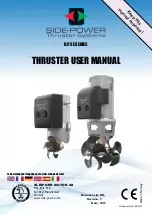
3
5915
3
2019
-
SE user manual
DECLARATION OF CONFORMITY
Sleipner Motor AS
P.O. Box 519, Arne Svendsensgt. 6-8
N-1612 Fredrikstad, Norway
Declare that this product with accompanying standard control systems complies with
the essential health and safety requirements according to:
DIRECTIVE 2013/53/EU
DIRECTIVE 2014/30/EU
DIRECTIVE 2014/35/EU
MC_0020
MC_0004
Important Thruster User Considerations and Precautions
EN
• Ensure you know the location of the main battery switch that disconnects the thruster from all power sources (batteries) so the thruster can
be turned off in case of serious malfunction.
• Always turn the main power switch off before touching any part of the thruster, An incidental start while touching moving parts can cause serious
injuries.
• Always turn the control device off when the thruster is not in use.
• The maximum continuous run time of the electrical thruster is approximately 3 minutes. The electromotor has a built-in thermal cut-off switch that will
shut off the electro-motor if it is overheating and re-engage when it has cooled down. Consider this when planning your manoeuvring.
• As above the thruster will limit its total running time per period. Do not count on the thruster to hold you in a strong current or side wind for extensive
periods. Depending on the surrounding temperatures etc. the thruster will be able to run approximately 10 % of the time.
• Never use thrusters close to objects/ persons or animals in the water, as the thruster will draw objects into the tunnel and contact with the
rotating propellers will cause serious injuries and damage the thruster.
• With the boat on land, only run the thruster for a fraction of a second, as without resistance it will accelerate very fast to a potentially damaging rpm.
• While the thruster is in the air, ensure that the propellers have come to a complete stop before performing a directional change of the thruster, as it
might cause damage to the thruster.
• If the thruster stops giving thrust while the electro-motor is running, there is possibly a problem in the drive system. You must immediately
stop running the thruster and turn it off . Running the electromotor for more than a few seconds without resistance from the propeller can cause
serious damage to the electromotor.
• When leaving the boat always turn off the main power switch for the thruster.
• We advise keeping the main engine(s) running while using the thruster. This will keep the batteries in a good charge condition. It will also give better
performance to the thruster, a higher voltage at the thruster results in a higher torque (power) in the electromotor.
• Please note the performance of the thruster strongly depends on the voltage available at the electromotor. This voltage will decrease over time
because ageing batteries have reduced capacity. Installing new batteries will bring back the thruster to the original level.
• Ensure only one control is used at the same time, if two panels are operated in opposite directions at the same time the thruster will not run. If
both are operated in the same direction, the thruster will run in this direction.
• If the thruster is not performing or functioning as usual, the cause must be found and corrected as soon as possible to avoid causing any other or
further damage to the equipment. You must also turn off the main battery switch immediately in case the problem is of electric origin.
• Never store items (e.g. equipment, sails, ropes etc.) in the same compartment as the thruster. When the thruster runs for an extended period, it can
reach 100°C and will cause damage to nearby items. The electromotor will generate some carbon dust so any storage compartment must be
separated from the thruster to prevent nearby items from becoming dusty/ dirty. Any loose items near the thruster motor can cause problems with
electrical wiring coming loose and short-circuiting.
• The electromotor, its components, contacts/ plugs or other joints in the control cables must be mounted so they will remain dry at all times.
• It is the owner/ captain/ other responsible parties full responsibility to assess the risk of any unexpected incidents on the vessel. If the thruster stops
giving thrust for some reason while manoeuvring you must have considered a plan on how to avoid damage to persons or other objects.
• The primary purpose of the thruster is to manoeuvre/ dock the vessel. Forward/ reverse speed must not exceed 4 knots when operated.
IMPORTANT
Failure to follow the Considerations and precautions can cause serious injury / damage and will render all warranty given
by Sleipner Motor AS VOID.
Содержание DC Series
Страница 11: ...11 5915 3 2019 SE user manual MC_0037 Notes EN ...
Страница 12: ...12 5915 3 2019 SE user manual MC_0037 Notes EN ...
Страница 13: ...13 5915 3 2019 SE user manual MC_0037 Notes EN ...
Страница 14: ...14 5915 3 2019 SE user manual MC_0037 Notes EN ...

































